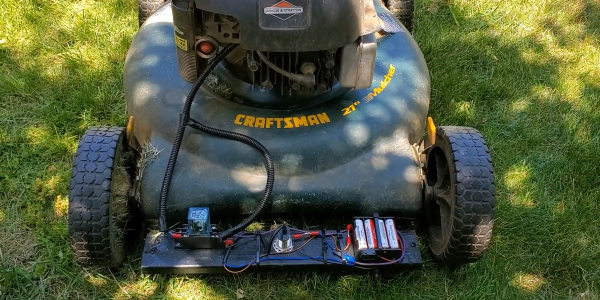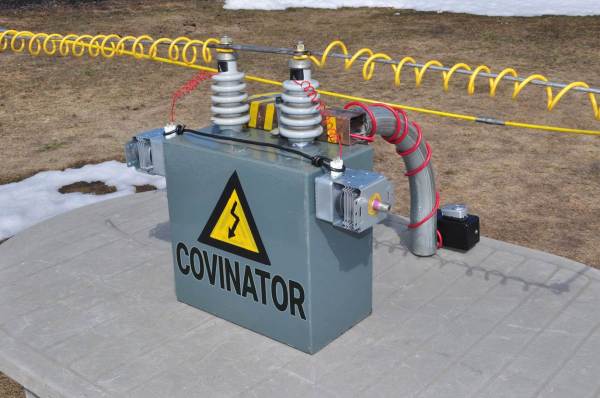If development platforms were people, Google would be one of the most prolific serial killers in history. Android Things, Google’s attempt at an OS for IoT devices, will officially start shutting down on January 5, 2021, and the plug will be pulled for good a year later. Android Things, which was basically a stripped-down version of the popular phone operating system, had promise, especially considering that Google was pitching it as a secure alternative in the IoT space, where security is often an afterthought. We haven’t exactly seen a lot of projects using Android Things, so the loss is probably not huge, but the list of projects snuffed by Google and the number of developers and users left high and dry by these changes continues to grow. Continue reading “Hackaday Links: December 20, 2020”
safety104 Articles
Retrotechtacular: Shake Hands With Danger
OK, you’re going to have to engage your safety squints and sit back to enjoy this one: a classic bit of safety propaganda from US heavy-equipment manufacturer Caterpillar from 1980 entitled “Shake Hands with Danger.”
Actually, you’ll probably need to engage your schlock filters for this 23-minute film too, as both the writing and the theme song are pretty hard to take. The film is one of those “Scared Straight” attempts to show just how horrifically wrong things can go both in the field and in the shop when working on anything made of stuff stronger than human flesh and bone. And in that regard, the film is highly effective — we found ourselves getting a bit queasy at a few points, with the poor dude who got his hand sucked into a bench grinder being both terrifying and relatable. [Three-Finger Joe] indeed.
Now, you might take exception with the acting, but as you watch all these vignettes, keep in mind that these are all old-school stunts — that’s actually a gigantic D9 bulldozer they crashed, and that brake chamber explosion really blew out that truck’s windows. They did a great job making the potential consequences of a moment’s thoughtlessness sickeningly vivid. Especially that arm-in-the-linkages scene. Ugh.
Whatever way you practice the hacking arts, stay safe out there. And don’t “Shake Hands with Danger.”
Continue reading “Retrotechtacular: Shake Hands With Danger”
A Lawnmower That Looks Where You’re Going
As a kid, one of the stories my dad told me was about mowing a fairly large field of grass on the farm with a gas-powered push mower. One day, some sort of farm tool was left in the field and the old industrial mower shredded it, sending a large piece of sharp metal hurtling toward his leg. Luckily for my dad, the large plastic wheel managed to stop the piece of metal, destroying the wheel. My grandfather was frustrated that he needed to repair the lawnmower but was grateful that my dad still had both feet attached.
Of course, this story was used as a lesson for me not to gripe about having to mow the lawn when it was my turn, but there was also the lesson that lawnmowers can be dangerous. [DuctTape Mechanic] took it upon himself to see if he could prevent that sort of accident altogether and has created an automatic safety shutdown mechanism for his family lawnmower. (Video embedded below.)
This uses an inductive sensor that can detect metal before it gets sucked into the mower itself. The sensor trips a relay which forcibly shuts the mower down by grounding the ignition coil. While it doesn’t physically stop the blade like other safety mechanisms, it does prevent a situation from escalating by turning off power to the blade as soon as possible. Getting to the ignition coil wasn’t easy as it required getting deep into the engine itself, but now [DuctTape Mechanic] has a mower that could be expanded further with things such as with a capacitive sensor or more smarts to determine if it is detecting underground or above ground metal.
Someday we’ll have robotic mowers, but until then, we laud the efforts of hackers out there trying to make the world a little safer.
Continue reading “A Lawnmower That Looks Where You’re Going”
Hackaday Links: May 24, 2020
We’re saddened to learn of the passing of Gershon Kingsley in December 2019 at the age of 97. The composer and electronic music pioneer was not exactly a household name, but the things he did with the Moog synthesizer, especially the surprise hit “Pop Corn”, which he wrote in 1969, are sure to be familiar. The song has been covered dozens of times, in the process of which the spelling of the name changed to “Popcorn.” We’re most familiar with the 1972 cover by Hot Butter, an earworm from our youth that doesn’t hide the Moog as deeply in the backing instruments as Kingsley did in the original. Or, perhaps you prefer the cover done by a robotic glockenspiel, because robotic glockenspiel.
A few months back, we covered the audacious plan to recover the radio gear from the Titanic. At the time, the potential salvors, Atlanta-based RMS Titanic, Inc., were seeking permission to cut into the submerged remains of the Titanic‘s Marconi room to remove as much of the wireless gear as possible. A federal judge granted permission for the salvage operation last Friday, giving the company the green light to prepare an expedition for this summer. The US government, through the National Oceanic and Atmospheric Administration and the National Park Service, argued strenuously to leave the wreck be and treat it as a tomb for the 1,527 victims. For our part, we had a great discussion about the merits in the comments section of the previous article. Now that it’s a done deal, we’d love to hear what you have to say about this again.
Although life appears to be slowly returning to what passes for normal, that doesn’t mean you might not still have some cycles to spare, especially when the time spent can bolster your skillset. And so if you’re looking to adding FPGAs to your resume, check out this remote lab on FPGA vision systems offered by Bonn-Rhein-Sieg University. The setup allows you to watch lectures, download code examples, and build them on your local computer, and then upload the resulting binaries to real hardware running on the lab’s servers in Germany. It sounds like a great way to get access to FPGA hardware that you’d otherwise have a hard time laying hands on. Or, you know, you could have just come to the 2019 Hackaday Superconference.
Speaking of skill-builders, oscilloscope owners who want to sharpen their skills could do worse than to listen to the advice of a real scope jockey like Allen Wolke. He recently posted a helpful video listing the five most common reasons for your scope giving “wrong” voltage readings. Spoiler alert: the instrument is probably doing exactly what you told it to do. As a scope newbie, we found the insights very helpful, and we can imagine even seasoned users could make simple mistakes like using the wrong probe attenuation or forgetting that scope response isn’t flat across its bandwidth.
Safety tip for the gearheads among us: your jack stands might be unsafe to use. Harbor Freight, the stalwart purveyor of cheap tools, has issued a recall of two different models of its jack stands. It seems that the pawls can kick out under the right conditions, sending the supported load crashing to the ground. This qualifies as a Very Bad Day for anyone unlucky enough to be working underneath when it happens. Defective jack stands can be returned to Harbor Freight for store credit, so check your garage and be safe out there in the shop.
And finally, because everyone loves a good flame war, Ars Technica has come up with a pronunciation guide for common tech terms. We have to admit that most of these are not surprising; few among the technology literate would mispronounce “Linux” or “sudo”. We will admit to a non-fanboy level of ignorance on whether the “X” in “iOS X” was a Roman numeral or not, but learning that the “iOS” part is correctly pronounced as three syllables, not two was a bit shocking. It’s all an exercise in pedantry that reminds us of a mildly heated discussion we had around the secret Hackaday writers’ bunker and whether “a LED” or “an LED” is the correct style. If the Internet was made for anything, it was stuff like this.
CNC Plasma Cutter Filter Gets The Slag Out
No matter what kind of tools and materials you use in your shop, chances are pretty good that some process is going to release something that you don’t want to breathe. Table saw? Better deal with that wood dust. 3D-printer? We’ve discussed fume control ad nauseam. Soldering? It’s best not to inhale those flux fumes. But perhaps nowhere is fume extraction more important than in the metal shop, where vaporized bits of metal can wreak respiratory havoc.
Reducing such risks was [Shane Wighton]’s rationale behind this no-clean plasma cutter filter. Rather than a water table to collect cutting dross, his CNC plasma cutter is fitted with a downdraft table to suck it away. The vivid display of sparks shooting out of the downdraft fans belied its ineffectiveness, though. [Shane]’s idea is based on the cyclonic principle common to woodshop dust collectors and stupidly expensive vacuum cleaners alike. Plastic pipe sections, split in half lengthwise and covered in aluminum tape to make them less likely to catch on fire from the hot sparks, are set vertically in the air path. The pipes are arranged in a series of nested “S” shapes, offering a tortuous path to the spark-laden air as it exits the downdraft.
The video below shows that most of the entrained solids slow down and drop to the bottom of the filter; some still pass through, but testing with adhesive sheets shows the metal particles in the exhaust are much reduced. We like the design, especially the fact that there’s nothing to clog or greatly restrict the airflow.
Looking for more on CNC plasma cutter builds? We’ve got you covered, from just the basics to next-level.
Continue reading “CNC Plasma Cutter Filter Gets The Slag Out”
Enforce Social Distancing With High Voltage
When getting parts together for a one-off project, we often find ourselves with some leftovers on hand. Most of the time these things go in the junk drawer, but [Brad] aka [AtomicZombie] was working on a project which required parts salvaged from several microwave ovens. That left him with enough surplus components to build a social distancing enforcement tool for the modern age; which will deliver a taser-like shock to anyone which violates the new six-foot rule.
The leftover parts in question were built around a high-voltage capacitor, which [Brad] strapped to his back to hold all of the electronics needed for the six-foot electrified hoop. The generator utilizes the output voltage from two magnetrons, but doesn’t start until the operator enters a code on the front control panel, which is about the only safety device on this entire contraption. To get power to the magnetrons a 12 VDC car battery is used with an inverter to get the required input voltage, and towards the end of the video linked below he shows its effectiveness by setting various objects on fire with it.
While this gag project is unlikely to get any actual use, it’s not like any of us around here need an excuse to play with high voltages. [Brad] is also unlikely to need it either; he lives on a secluded 100-acre homestead and has been featured here for some of the projects he built to make his peaceful life a little easier, like a robotic laundry line, mobile chicken coop, and an electric utility tricycle built from an old truck and motorcycle.
Continue reading “Enforce Social Distancing With High Voltage”
Google And Apple Reveal Their Coronavirus Contact Tracing Plans: We Kick The Tires
Google and Apple have joined forces to issue a common API that will run on their mobile phone operating systems, enabling applications to track people who you come “into contact” with in order to slow the spread of the COVID-19 pandemic. It’s an extremely tall order to do so in a way that is voluntary, respects personal privacy as much as possible, doesn’t rely on potentially vulnerable centralized services, and doesn’t produce so many false positives that the results are either ignored or create a mass panic. And perhaps much more importantly, it’s got to work.
Slowing the Spread
As I write this, the COVID-19 pandemic seems to be just turning the corner from uncontrolled exponential growth to something that’s potentially more manageable, but it’s not clear that we yet see an end in sight. So far, this has required hundreds of millions of people to go into essentially voluntary quarantine. But that’s a blunt tool. In an ideal world, you could stop the disease globally in a couple weeks if you could somehow test everyone and isolate those who have been exposed to the virus. In the real world, truly comprehensive testing is impossible, and figuring out whom to isolate is extraordinarily difficult due to two factors: COVID-19 has a long incubation period during which it is nonetheless transmissible, and some or even most people don’t know they have it. How can you stop what you can’t see, and even when you can detect it, it’s a week too late?
One promising approach is to isolate those people who’ve been in contact with known cases during the stealth contagion period. To do this is essentially to keep a diary of everyone you’ve been in contact with for the last week or two, and then if you eventually test positive for COVID-19, alert them all so that they can keep from infecting others even before they test positive: track and trace. Doctors can do this by interviewing patients who test positive (this is the “contact tracing” we’ve been hearing so much about), but memory is imperfect. Enter a technological solution. Continue reading “Google And Apple Reveal Their Coronavirus Contact Tracing Plans: We Kick The Tires”

















